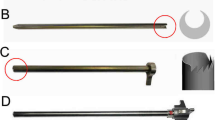Abstract
Purpose
We aimed to investigate the surgical strategy, safety, and efficacy of percutaneous endoscopic decompression via transforaminal approach for lumbar lateral recess stenosis in geriatric patients.
Methods
From January 2012 to June 2014, 25 elderly patients (18 males and 7 females) with symptomatic lumbar lateral recess stenosis were performed percutaneous endoscopic transforaminal decompression. The ages of patients ranged from 70 to 93 years (mean 79.6 years). Clinical outcomes were assessed mainly by leg pain visual analogue scale (VAS), Oswestry disability index (ODI) score, MacNab criteria, and post-operative computerized tomographic (CT) scanning.
Results
The surgery was successfully completed in all patients with an average operation time of 75 minutes (range, 50–110 min). The lumbar CT images at two days after the operation demonstrated distinct enlargement of the foramen intervertebrale as well as satisfactory decompression of the lumbar lateral recess. And 24 patients of the group were followed up for a mean duration of 29 ± six months (range, 12–44 months). The leg pain VAS score decreased from 8.52 ± 1.11 pre-operatively to 1.80 ± 0.63, 1.33 ± 0.89, 1.05 ± 0.69, and 0.71 ± 0.50 at one, three, six and 12 months after the operation, respectively. Besides, the ODI score also dropped from 59.43 ± 10.04 pre-operatively to 29.42 ± 10.33, 20.13 ± 8.18, 13.98 ± 6.16, and 9.86 ± 5.03 at one, three, six and 12 months during the post-operative follow-up period. Statistically significant differences existed in both VAS score and ODI score at each follow-up time point when compared with the pre-operative scores (P < 0.05). The mean reciprocal angulation change of the operated segment in dynamic lumbar lateral view was 3.2° ± 1.6° at the last follow-up. And there were 18 excellent cases, three good cases, and three fair cases according to the MacNab criteria, and the excellent and good rate was 87.5% at 12 months after the operation. There was no aggravation of the coexisting medical conditions after operation in this group. Only 1 case was found complicated with lower extremity numbness, which was recovered by conservative treatment for two weeks. No persistent neurological deficit or soft tissue infection occurred in all patients post-operatively.
Conclusions
We considered that percutaneous endoscopic transforaminal decompression achieved satisfactory results and provided a safe, effective, and less invasive alternative for treating lumbar lateral recess stenosis in geriatric patients.


Similar content being viewed by others
References
Ruetten S, Komp M, Merk H, Godolias G (2009) Surgical treatment for lumbar lateral recess stenosis with the full-endoscopic interlaminar approach versus conventional microsurgical technique: a prospective, randomized, controlled study. J Neurosurg Spine 10(5):476–485
Nellensteijn J, Ostelo R, Bartels R (2010) Transforaminal endoscopic surgery for symptomatic lumbar disc herniations: a systematic review of the literature. Eur Spine J 19(2):181–204
Ruetten S, Komp M, Merk H, Godolias G (2007) Use of newly developed instruments and endoscopes: full-endoscopic resection of lumbar disc herniations via the interlaminar and lateral transforaminal approach. J Neurosurg Spine 6(6):521–530
Fan G, Han R, Gu X, Zhang H, Guan X, Fan Y, Wang T, He S (2017) Navigation improves the learning curve of transforamimal percutaneous endoscopic lumbar discectomy. Int Orthop 41(2):323–332
Ruetten S, Komp M, Merk H, Godolias G (2008) Full-endoscopic interlaminar and transforaminal lumbar discectomy versus conventional microsurgical technique: a prospective, randomized, controlled study. Spine 33(9):931
Eun SS, Lee SH, Sabal LA (2016) Long-term follow-up results of percutaneous endoscopic lumbar discectomy. Pain Physician 19(8):E1161–E1166
Du J, Tang X, Jing X, Li N, Wang Y, Zhang X (2016) Outcomes of percutaneous endoscopic lumbar discectomy via a translaminar approach, especially for soft, highly down-migrated lumbar disc herniation. Int Orthop 40(6):1247–1252
Ahn Y (2014) Percutaneous endoscopic decompression for lumbar spinal stenosis. Expert Rev Med Devices 11(6):605–616
Bartynski WS, Lin L (2003) Lumbar root compression in the lateral recess: MR imaging, conventional myelography, and CT myelography comparison with surgical confirmation. AJNR Am J Neuroradiol 24(3):348–360
Macnab I (1971) Negative disc exploration: an analysis of the causes of nerve-root involvement in sixty-eight patients. J Bone Joint Surg Am 53(5):891
Ren C, Song Y, Liu L, Xue Y (2014) Adjacent segment degeneration and disease after lumbar fusion compared with motion-preserving procedures: a meta-analysis. Eur J Orthop Surg Traumatol 24(1):245–253
Ong KL, Auerbach JD, Lau E (2014) Perioperative outcomes, complications, and costs associated with lumbar spinal fusion in older patients with spinal stenosis and spondylolisthesis. Neurosurg Focus 36(6):E5
Chen HC, Lee CH, Wei L, Lui TN, Lin TJ (2017) Comparison of percutaneous endoscopic lumbar discectomy and open lumbar surgery for adjacent segment degeneration and recurrent disc herniation. Neurol Res Int 2015:1–5
Ruetten S, Komp M, Hahn P, Oezdemir S (2013) Decompression of lumbar lateral spinal stenosis: full-endoscopic, interlaminar technique. Oper Orthop Traumatol 25(1):31–46
Hussain M, Berger M, Eckenhoff RG et al (2014) General anesthetic and the risk of dementia in elderly patients: current insights. Clin Interv Aging 9(9):1619–1628
Pulido-Rivas P, Sola RG, Pallares-Fernández JM, Pintor-Escobar A (2004) Lumbar spinal surgery in elderly patients. Rev Neurol 39(6):501–507
Jasper GP, Francisco GM, Telfeian AE (2013) A retrospective evaluation of the clinical success of transforaminal endoscopic discectomy with foraminotomy in geriatric patients. Pain Physician 16(3):225–229
Weber C, Giannadakis C, Rao V et al (2016) Is there an association between radiological severity of lumbar spinal stenosis and disability, pain, or surgical outcome?: a multicenter observational study. Spine 41(2):E78–E83
Choi I, Ahn JO, So WS, Lee SJ, Choi IJ, Kim H (2013) Exiting root injury in transforaminal endoscopic discectomy: preoperative image considerations for safety. Eur Spine J 22(11):2481–2487
Yeung AT, Yeung CA (2003) Advances in endoscopic disc and spine surgery: foraminal approach. Surg Technol Int 11(11):255–263
Author information
Authors and Affiliations
Corresponding author
Rights and permissions
About this article
Cite this article
Chen, X., Qin, R., Hao, J. et al. Percutaneous endoscopic decompression via transforaminal approach for lumbar lateral recess stenosis in geriatric patients. International Orthopaedics (SICOT) 43, 1263–1269 (2019). https://doi.org/10.1007/s00264-018-4051-3
Received:
Accepted:
Published:
Issue Date:
DOI: https://doi.org/10.1007/s00264-018-4051-3




